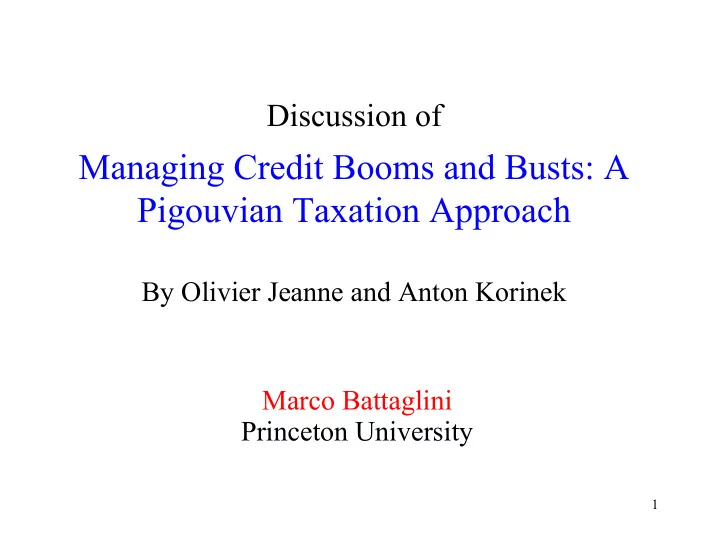

Discussion of Managing Credit Booms and Busts: A Pigouvian Taxation Approach By Olivier Jeanne and Anton Korinek Marco Battaglini Princeton University 1
• This paper presents a theory of fluctuations in consumption due to credit markets imperfections. • The authors emphasize the failure of consumers to internalize their savings decisions on asset prices as a source of the fluctuations. They argue in favor of a “Pigouvian tax.” • They provide a quantitative assessment of the theory: ‒ τ ≈ 0.5% of outstanding debt. • I have enjoyed reading the paper very much! 2
• In my discussion: − Illustrate the main ideas of the paper; − Propose a different interpretation; − In the light of this, discuss policy implications. 3
I. The main idea • Key ingredients: • Citizens are endowed with a partially tradable asset: ‒ Only locals can own it. Its price is p t . ‒ It generates a stochastic flow of income y t . ≤ φ • Imperfect credit market require collateral: debt p t • Two observations: ‒ We have a feedback effect: c ↓ → p ↓ → debt ↓ → c ↓ Credit imperfections amplify fluctuations in c. 4
‒ Agents are price-takers. Agent i does not internalize that: t ↓ → Ec i t+1 ↓ → Ep t ↓ → Ec j ↓ s i t+1 • The authors conclude: we need a Pigouvian tax that forces the consumers internalize this “externality.” 5
II. Is the externality the problem? ‒ A price externality is present even in a standard unconstrained Pareto efficient competitive equilibrium. ‒ Here, price changes have a first order effect on welfare because the allocation is inefficient when the collateral constraint is binding. • The planner smoothes the cost of the distortion by taxing in good times and subsidizing consumption in bad times. • There is however no need to tax private debt (which may be very distortive both on consumption and on investment). 6
• A lump sum tax on income may be superior, and always be used: − It does not fix the “price externality” − By smoothing asset prices, it fixes the cause of the problem. • Even when income taxation is distortionary, it is necessary in a constrained optimum. • Bottom line: we can not discuss welfare implications of the Pigouvian tax if we ignore the rest of fiscal policy. This is a problem of public debt management. 7
III. The calibration • The authors do a good job in exploring the quantitative implications of the model: − Without the explicit consideration of a richer policy mix, the argument for a “Pigouvian tax” is not persuasive. Partial equilibrium assumption that β R<1 is − problematic. • The theoretical model however is a good platform to study the issues that I have tried to highlight in this discussion. 8
Recommend
More recommend